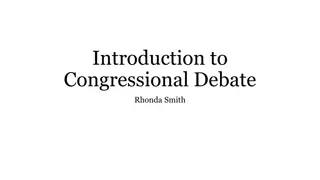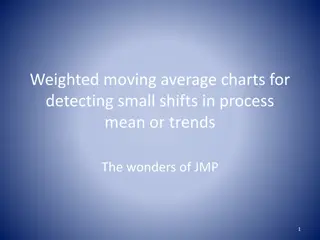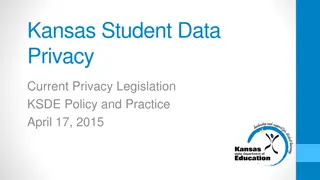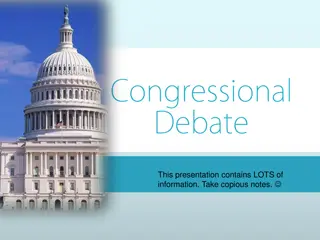Moving Beyond the Access-Use Debate in Current Data Legislation
This article delves into the current legislation surrounding personal data processing, emphasizing principles like lawfulness, fairness, transparency, purpose limitation, data minimization, and accuracy. It explores the intricacies of the access-use debate concerning big data and proposes regulations for the analysis phase, aiming to move beyond traditional frameworks.
Download Presentation

Please find below an Image/Link to download the presentation.
The content on the website is provided AS IS for your information and personal use only. It may not be sold, licensed, or shared on other websites without obtaining consent from the author. Download presentation by click this link. If you encounter any issues during the download, it is possible that the publisher has removed the file from their server.
E N D
Presentation Transcript
Moving beyond the access-use debate Bart van der Sloot Tilburg Institute for Law, Technology, and Society (TILT) Tilburg University, Netherlands www.bartvandersloot.com
Overview 1. Current legislation 2. Big Data 3. Access-Use debate 4. Moving beyond it 5. Regulation of the analysis phase
1. Current legislation (1) personal data means any information relating to an identified or identifiable natural person ( data subject ); an identifiable natural person is one who can be identified, directly or indirectly, in particular by reference to an identifier such as a name, an identification number, location data, an online identifier or to one or more factors specific to the physical, physiological, genetic, mental, economic, cultural or social identity of that natural person; (2) processing means any operation or set of operations which is performed on personal data or on sets of personal data, whether or not by automated means, such as collection, recording, organisation, structuring, storage, adaptation or alteration, retrieval, consultation, use, disclosure by transmission, dissemination or otherwise making available, alignment or combination, restriction, erasure or destruction;
1. Current legislation Article 5 Principles relating to processing of personal data 1. Personal data shall be: (a) processed lawfully, fairly and in a transparent manner in relation to the data subject ( lawfulness, fairness and transparency ); (b) collected for specified, explicit and legitimate purposes and not further processed in a manner that is incompatible with those purposes; further processing for archiving purposes in the public interest, scientific or historical research purposes or statistical purposes shall, in accordance with Article 89(1), not be considered to be incompatible with the initial purposes ( purpose limitation ); (c) adequate, relevant and limited to what is necessary in relation to the purposes for which they are processed ( data minimisation ); (d) accurate and, where necessary, kept up to date; every reasonable step must be taken to ensure that personal data that are inaccurate, having regard to the purposes for which they are processed, are erased or rectified without delay ( accuracy );
1. Current legislation (e) kept in a form which permits identification of data subjects for no longer than is necessary for the purposes for which the personal data are processed; personal data may be stored for longer periods insofar as the personal data will be processed solely for archiving purposes in the public interest, scientific or historical research purposes or statistical purposes in accordance with Article 89(1) subject to implementation of the appropriate technical and organisational measures required by this Regulation in order to safeguard the rights and freedoms of the data subject ( storage limitation ); (f) processed in a manner that ensures appropriate security of the personal data, including protection against unauthorised or unlawful processing and against accidental loss, destruction or damage, using appropriate technical or organisational measures ( integrity and confidentiality ). 2. The controller shall be responsible for, and be able to demonstrate compliance with, paragraph 1 ( accountability ).
1. Current legislation Legitimate ground for processing personal data Legitimate ground for processing sensitive personal data Legitimate ground for transfering personal data
1. Current legislation Records Data protection officer Data protection impact assessment Technical and organisational security measures Transparancy
1. Current legislation Right to access Right to information Right to a copy + data portability Right to be forgotten Right to rectification Right to object Right not to be subjected to automatic decision making
2. Big Data Umbrella term: Open Data (the idea that data should be open and accessible for everyone and not privatised by a certain organisation or person), Re-Use (the belief that data can always be used for new purposes/that data can always have a second life), Algorithms (the computer programs used to analyse the data and produce statistical correlations), Profiling (Big Data analysis usually makes use of categories and predictions, such as that 20% of the people with a red car also like rap music, that 40% of the men that have a house with a value over 250.000,- are over the age of 50 or that 0,01% of the people that go to Yemen for vacation, visit extreme terrorist websites and are between the age of 15-30 are potential terrorists), Internet of Things (IoT) (the trend to install sensors on objects and connect them to the internet, so that the chair, street light and vacuum cleaner can gather data about their environment), Smart Applications (the trend of making the internet-connected devices resonate with their environment and letting them make independent choices the smart street light that shines brighter when it rains, the smart refrigerator that orders a new bottle of milk, the smart washing machine that turns on whenever the power usage in the area is low, etc.),
2. Big Data Cloud Computing (the fact that data can be stored globally and can be located in Ghana at one moment in time and in Iceland the next day, when there is storage capacity in that specific data centre at that specific moment), Datafication (the trend to rely more on data about reality than on reality itself), Securitization (the usage of risk profiles in order to prevent potential threats from materialising), Commodification (the trend to commercially exploit data), Machine Learning (the possibility that machines and algorithms can learn independently e.g. deep learning, through which algorithms can learn from their environment and adapt beyond how they have been programmed to behave) and Artificial Intelligence (AI) (the trend to rely more and more on computer intelligence, with some experts saying that AI will outplace human intelligence in a decade or two).
2. Big Data Node for various developments: Big Data is also a term used to bring together various developments, such as most obviously technological evolutions, through which the gathering and storing of data is increasingly easy, through which analysing information can be done increasingly swift and yield ever more valuable results and through which these outcomes can be used for innovative application in more and more fields of life. In addition, there are economic developments underlying the concept of Big Data, such as that the costs for these technologies are declining every year, which has led to a democratisation of the data-applications; in addition, the costs for gathering, storing and analysing data are so low that the economic rationale is seldom a reason to stop or abstain from gathering and storing data. To provide a final example, Big Data is also used to address several societal tendencies, such as those mentioned above: datafication, commodification, securitisation, etc.
2. Big Data Historical fluid: There is no specific moment in time when Big Data was invented. Rather, most elements used for current Big Data applications have existed for decades. What has changed is that the data technologies have become quicker, the databases bigger and the reliance on data-analysis firmer, but these are gradual changes. What we call Big Data now will be small data in a decade or so.
2. Big Data Fluid by definition: There is no standard definition of Big Data. The most commonly used definition is the so called the 3V model, in which the phenomenon is defined in terms of Volume (the amount of data), Variety (the number of data sources) and Velocity (the speed at which the data can be analysed). In addition, others have added Vs, such as Value (the value Big Data represents), Variability (the speed at which Big Data processes change), and Veracity (the exactitude of Big Data processes). What is mutual to all these elements is that they are gradual. There is not a precise moment at which the database becomes so big that one can speak of Big Data e.g. that a database of 1000 datapoints is not Big Data but a database with 1001 datapoints would be. The same counts for the other elements. There is not a specific moment at which the data-analysis is so quick that it can be called Big Data or a moment at which there are so many different data-sources that one can speak of Big Data, e.g. that 10 datasources is not Big Data but 11 would be. The other way around, not all of these elements should necessarily be fulfilled to speak of Big Data. For example, some datasets that are big and are analysed with smart algorithms at rapid speed, but only derive from one data-source are still called Big Data. Rather than defining Big Data, Big Data should be treated as an ideal type the more data are gathered, the more data sources are merged, the higher the velocity at which the data are analysed, etc., the more a certain phenomenon approaches the ideal type of Big Data.
2. Big Data Gathering: With regard to the volume of data, the basic philosophy of Big Data is the more, the merrier . The larger the dataset, the more interesting patterns and correlations can be found, the more valuable the conclusions drawn therefrom. What is said to set Big Data technologies apart is precisely that, relying on smart computers and self-learning algorithms, they can work on extremely large sets of data. By being confronted with a constant stream of new data, these programs can continue to learn and become 'smarter'. It is important that Big Data can not only be used for the collection of data, but also for the production of data. This is done through inferring new data from old data. With respect to the variety of data sources, it should be underlined that Big Data facilitates linking and merging different data sources. For example, an existing database can be linked to a database of another organization and subsequently enriched with information that is scraped from the internet. Big Data is also said to work well on so-called unstructured data, that are uncategorised. Because Big Data is essentially about analysing very large amounts of data and detecting general and high level correlations, the quality of specific data is said to become less and less important quantity over quality. Because data gathering and storage is so cheap, data are often gathered without a predefined purpose, only determining afterwards whether data represent any value and if so, for what purposes they can be used.
2. Big Data Analysing: Once the data have been collected, they will be stored and analysed. The analysis of the data is typically focussed on finding general characteristics, patterns and group profiles (groups of people, objects of phenomena). General characteristics can be derived, for example regarding how earthquakes typically evolve, which indicators can be designated that can predict an upcoming earthquake and which type of buildings remains relatively undamaged after such disasters. An important part of Big Data is that the computer programs used for analysing data are typically based on statistics the analysis revolves around finding statistical correlations and not around finding causal relations. The statistical correlations usually involve probabilities. It can thus be predicted that of the houses built with a concrete foundation. 70% will remain intact after an earthquake, while of the houses without a concrete foundation, this only holds true for 35%, or that people that place felt pads under the legs of their chairs and tables on average repay their loan more often than people who do not. This also brings the last point to the fore, namely that with Big Data, information about one aspect of life can be used for predictions about whole other aspects. It may appear that the colour of a person s couch has a predictive value for his health, that the music taste of a person s friends on Facebook says something about his sexual orientation and that the name of a person s cat has a predictive value for his career path.
2. Big Data Usage: The correlations gained from Big Data analysis can be used at the general level, for example when policy choices are based on the prediction that in 20 years time, halve of the population will be obese; they can be used to make predictions about groups of people, events or objects, such as bridges, immigrants or men with red cars and big houses; and they can be applied to specific, individual cases, projecting the general profile on a specific case.
3. Access-Use debate 1. Data minimization 2. Purpose specification 3. Purpose limmitation 4. Storage limmitation 5. Data quality 6. Security and confidentiality 7. Transparancy 8. Individual rights 9. Cross border data flows 10. Control and responsibility
3. Access-Use debate Move to a use based approach? First, they argue that the legal realm is simply outdated or out of touch with reality; such experts suggest that the GDPR, which has just recently been adopted and will only come into effect as of May 2018, is based on a nineties understanding of data and technology. Whereas in the end of last century, it was still possible to set limits to the gathering of data, in the Big Data era, access to information is simply a given. It is no longer possible to set restrictions on the gathering of data. In fact, these experts point to the actual state of affairs and suggest that the EU regulator is simply out of touch with reality and unaware of the phenomenon Big Data. It seems beyond doubt that this inadequate sense of realism also manifests itself in respect of privacy regulations. This inadequate sense of realism with regard to privacy regulations limits the chance of such regulations being embraced in anything more than a rhetorical manner, and indeed this has become the hallmark of existing privacy legislation. Frequently, there is a lack of any concrete development or real accountability with regard to the more universal claims and ambitions of these regulations.
3. Access-Use debate Second, the argument is put forward that by setting limits to the first phase of Big Data, during which data are gathered, new innovations and the commercial exploitation of data by companies and governmental organisations are curtailed. They point to the value and potential of Big Data and suggest that even if it would be possible to enforce the current access-based legal principles and put an end to the mass collection of data by governmental organisations, companies and citizens alike, this would simply be undesirable because it would muffle the economic growth, technological progress and societal developments that are facilitated by Big Data. That is why proponents of a use-based regulation of Big Data suggest that the gathering of personal data should no longer be restricted or that there should be substantially less hurdles in place for gathering personal data.
3. Access-Use debate Third, instead, the legal realm should be focussed on regulating the use of data, the third phase of Big Data processes, in which data and the insights gained from data analytics, are applied in practice and have a specific effect on citizens and society. It is the negative effects of data usage that should be curtailed, not the data gathering as such, such experts argue. When it is ensured that citizens and society alike benefit from Big Data processes, there is no reason to retain the access-based rules. Consequently, data-driven innovation can flourish while privacy protection can actually be ameliorated, proponents of a used-base regulation of Big Data argue.
3. Access-Use debate Others argue that the access based approach should be retained First, they believe that the proponents of a use-based approach are na ve; when there are no limits to gathering and storing data, they suggest, it will become unclear who has data, to what ends and how the data are used in practice. It is often unclear whether and to what extent decisions and applications in practice are in fact based on personal data, let alone who those data belong to. Analysing what effects applications have on people can be hard and very time- consuming and to what extent harms derive from data-usage requires a tedious and meticulous process. If such matters of interpretation are not taken up by a governmental watchdog on structural level, this would mean that individuals would themselves need to analyse in how far certain data processes have a negative effect on their position and are themselves responsible for defending their interests through legal means. In reality, individuals are often powerless against the large and resourceful Big Data organisations.
3. Access-Use debate In addition, they suggest that the EU-regulator is of course not out of touch with reality and is not unaware of Big Data technologies. Rather, the EU has signalled these developments and aims at stopping or curtailing those, among others, by setting very strict rules on when data can be gathered and how and by making clear in the General Data Protection Regulation that a violation of any of the five access-based rules discussed above can lead to a fine of up to 20 million or in the case of an commercial organisation, up to 4 % of the total worldwide annual turnover of the preceding financial year, whichever is higher. This means that it is not entirely unrealistic that the amount of data currently gathered may be limited when the GDPR comes into effect.
3. Access-Use debate Third, they suggest that a use based approach is undesirable, because gathering data about persons as such is problematic and a violation of human freedom, not only when data are used and have negative consequences for specific people or society at large. Consequently, rules on the gathering of and the access to data should remain in place and be reinforced in the Big Data era, although perhaps, new use-based regulation can be added on top of the access-based principles.
4. Moving beyond it Data are not neutral: Big Data processes involve statistical analysis. As everyone knows that has studied statistics, designing a proper research methodology, collecting reliable data and finding statistically relevant and significant correlations is hard. A first requirement to ensure reliable statistical outcomes is securing the reliability of the data and the dataset and to correct potential biases. First, the data must be representative for the actual situation. Suppose of the customers of a certain company, 34% are male, but the dataset contains data about 9000 women and only about 1000 men, this should be corrected in the data model. In the enthusiasm for Big Data, this simple step is often forgotten, not in the last place because organisations are not always aware of how the data were gathered, what biases existed in the research methodology and what would be a proper representation of reality. This problem is aggravated when scraping data from the internet, such as from Facebook, Twitter or other social media. Not only is it impossible to know what biases exist in the data and how to correct those, in addition, the way in which the platforms are designed also influence which data are posted by users and how. Designing a proper research methodology for gathering reliable data requires time and effort, because the way in which questions are posed to people can have a large influence on their answers. To provide a final example of the problem of biased datasets in Big Data processes is what is called the feedback loop. Take the police. The police traditionally surveys more in areas where many conflicts and problems arise. In the Netherlands, this would be the Bijlmer in Amsterdam, the Schilderswijk in The Hague and Poelenburg in Zaandam. A substantial part of the population in these neighbourhoods are immigrants or people that have an immigrant background. Consequently, these groups have an above average representation in the police databases. Subsequently, when the police decides where it should survey and deploy units, data analytics will suggest to focus on these neighbourhoods and people with these backgrounds, which will lead to an even higher number of datapoints about these areas and the groups living in those areas, etc.
4. Moving beyond it Updating data is not neutral: A second problem is that Big Data analytics is often based on incorrect data. Although the catch phrase of Big Data gurus is that Big Data can work with messy and incorrect data, quantity over quality , reality often proves different. Inadequate data lead to inadequate analytical results. In addition, data are often analysed when they are outdated. Out of the feeling that data can always have a second life and be re-used for new purposes, many organisations use the databases already in their possession for Big Data applications. Making predictions on the basis of old data obviously predicts the past. When organisations update the databases, a number of things go wrong. Most importantly, the metadata about the dataset how the data have been gathered, when, why and by whom is often non-existent; this makes it impossible to complement the outdated dataset with new data using the same methodology. Consequently, different data, with different biases are incorporated in the same database, which makes it almost impossible to correct those biases, which has the effect that the comparison between the data is inaccurate. Comparing data of different periods with the same bias may signal significant differences over time; when the datasets compared have different research designs, it becomes impossible to exclude the possibility that the differences found in the datasets are a result of the difference in methodology. More in general, a number of different factors may have an effect on why data about different time frames may be different, such as difference in legal and societal norms, difference in population, difference in the world economy, difference in environments, etc. These circumstances are often simply excluded from the research design.
4. Moving beyond it Categorising data is not neutral: Although again, a catch phrase of Big Data analytics is that it can work with messy and unstructured data, reality so far proves to be less bright. Categories are essential to understanding data, while at the same time, categories are non-neutral. Should a police database also include data about race, gender or religious background? Take only the most basic of categories Are you either male [] or female []? , which has been questioned recently, inter alia by people that feel they are neither and by people that affiliate with both genders. Choosing categories is a non-neutral endeavour. In addition, setting boundaries on who falls within which category often proves to be quintessential for the outcome of the analysis. This is a problem in Big Data processes in itself, because the categorisation in databases is often a result of usability (the databases in the possession of organisations were traditionally used by employees, board members and others) and not on reliability. This problem is aggravated when different databases are merged; even when the databases contain data on the same subject matter, it can be difficult to make choices on the categorisation of the merged database. A well-known example is that in one dataset, 'young adults' are persons between the age of 16-28, whereas in another dataset, the same term is used for persons between 18-26. Which of these two categories is used can have a large impact on the results. Every dataset has its own background and there are often reasons for specific demarcations. The first database concerns, for example, the moment when young people first have sex (with the age of 16 as the legal age for having sex with a person), while the second dataset may be about the intake of alcohol by young people (with the age of 18 years as the threshold for legally buying alcohol). These categories can therefore not be changed without significantly perverting the reliability of the dataset, whereas such practices are not uncommon to Big Data processes.
4. Moving beyond it Algorithms are not neutral: In addition, algorithms, the computer models used to analyse the data, themselves are not neutral. They are based on decision trees, which attach weight to certain factors more than to others. A good algorithm makes more accurate predictions than a bad algorithm, but both are based on assumption which are never always true. It is a decision tree that includes certain factors, but ignores others, attaches weight to factors and draws conclusions from the different weights. Although programmers are themselves often aware of the assumptions and biases in the algorithms and the need to correct the findings when using or applying the results gained through data analysis, this awareness is often lost on a managerial or board room level. In addition, there is the problem of blind spots. A well-known example is that predictive algorithms initially simply ignored the likelihood that women would commit terrorist attacks, making black widows the ideal perpetrators. The other way around, algorithms can have a bias towards certain ethnic groups, so that too much emphasis is put on those, making the data-based application ineffective and inaccurate.
4. Moving beyond it Queries are not neutral: As has been discussed, the data and the categories are not neutral, but also the queries run on those data should not be conceived as neutral. Suppose the police runs a database query searching for Muslims that are likely to commit a burglary in the coming month. Suppose the results show that there are 5 people that have a high probability of committing such crime. When the police starts monitoring those people, it can point to credible intelligence that these people may commit a crime. Although it is not unreasonable that the police should monitor those people s behaviour, the underlying research query is clearly biased. This example is extreme, namely based on intentional discrimination. More in general, however, every research query is biased as it is based on assumptions, a certain phrasing and potential expectations on the outcome. In addition, discrimination may not only follow from direct and intentional actions, but also as an indirect result. A query on postal code may have an important bias, as certain areas have a larger immigrant population than others, etc. In Big Data research, such queries are often put in the hand of managers, who more often than not do not have a clear understanding of the implicit assumptions in their research questions or the biases in the queries.
4. Moving beyond it Predictions are not facts: Big Data analytics typically revolve around predictions and probabilities. It can be found, through data analytics, that there is a 70% likelihood that men in possession of a red car and with right wing political beliefs will read the Wall Street Journal, or that there is a 23% change that certain types of bridges will collapse when there is an earthquake, or a 44% chance that extreme obesity will be the first cause of death in the Europe and the United States of America. There are two common mistakes in this respect. First, when using and applying the insights gained from data analytics, the predictions tend to be taken absolute, while the outcomes are probabilistic. Second, obviously, data analytics does not predict anything about a specific individual, car or house. It predicts something about the group. This is one of the reasons why doctors are often hesitant to predict the progression of certain diseases. The fact that 70% of the people recover from the disease says little about an individual patient. With Big Data processes, however, it is not uncommon to apply general correlations on specific individuals, such as with terrorism or crime prevention.
4. Moving beyond it False positives and negatives: As predictions are not facts, there are always problems in terms of false positives and false negatives. When there is a false positive, a prediction is made about something or someone that is ultimately not correct. This can sometimes be harmless, for example when someone is shown an advertisement of a product in which he is not actually interested. It can already be a waste of time when a bridge is predicted to be in need of repair, while it follows from the subsequent inspection that this is not the case. False positives are particularly problematic in the medical sector, when a patient is predicted to attract a particular disease, while that disease does not manifest itself at all. It is also problematic if a person is suspected and accused of a crime, while he turns out to be innocent. It can have a big impact on people if they are unjustly suspected of a crime or wrongly predicted to be ill in the future, and family life can be disrupted as a consequence. In the case of false negatives, there is the opposite problem. Again, little harm is done when someone does not see an advertisement of a product in which he is interested or if the automatic refrigerator has not ordered a new bottle of milk. More problematic is it when a person is not spotted as a potential terrorist, while he or she prepares an attack, or when a disease is not found in time, when the medical institution relies on Big Data analytics. One of the problems is that there are no thresholds in place for how high the number of false negatives and positives can be, so that organizations tend to spend little effort in marginalizing these false outcomes; at the same time, they often take the consequences of these false predictions as a given, as an integral part of doing Big Data analysis.
4. Moving beyond it Correlation is not causality: What is a reoccurring problem with Big Data analytics is a confusion of statistical correlations and causality. The fact that someone places felt pads under the legs of his chairs and tables can have a predictive value as to whether this person will repay his loan. However, it is not because he places felt pads under the legs of his chairs and tables that he repays his loan. The same goes for religious, cultural and ethnic background in relation to crime; although there may be a statistical correlation, this says nothing about causality. There is a famous anecdote about how this almost went wrong in the United States of America. The story goes that the governor of an American state saw with dismay that the children attending school often performed poorly and did not attend university. A large data-driven study was carried out into the school performance of children and it appeared that one of the factors with the greatest predictive value for school performance was the number of books in the house where the children grew up. The governor then decided to draw up a book plan; all the households in which children grew up had to be sent books to promote the school performance of children. Only at the last moment would this plan have been cut off, because the causal relationship was non-existent. It is not that children get smart because there are many books in their home, it is much more likely that, for example, highly educated parents both possess many books and stimulate and support their children in their school achievements.
4. Moving beyond it Experimentation: As a penultimate example of what might go wrong when analysing the data, it often occurs that large and general predictions are based on too small datasets (under the pretext of Big Data). This especially occurs in smaller organisations, such as schools, archives and retailers, who are keen on applying Big Data analytics in their organisation, but only have a limited dataset to work with. It is not uncommon that large policy decisions and strategic plans are based on a dataset with an n lower than 100. For example, some secondary schools base their admission policy on the data they have collected from one or two subsequent years. They have analysed from which district of the city the pupils came, which school advice they had and for example whether they are male or female and connect this to how they performed at high school. On the basis of data-analytics applied to data from one or two years, admission policies are designed. Obviously, such small samples cannot result in reliable statistical predictions, as every year is unique. Only with larger datasets can general patterns be discerned in a reliable manner.
4. Moving beyond it Falsification: As a final example of what often goes wrong with data analytics is that there is hardly any falsification of the results. A good example is predictive policing, about which there is little scientific evidence supporting its supposed efficacy. Rather, a number of police forces have stopped working with predictive policing out of a lack of results. Still, some police forces believe that in their case, predictive policing is effective, pointing to a decline of crime rates after the introduction of predictive policing. The causal relationship remains unproven. Comparative research often shows, for example, that in the same period in other cities, crime rates have also dropped, without deploying predictive policing. This may be due to, for example, general developments on which Big Data has no influence. Alternatively, positive outcomes may be due to the fact that predictive policing is applied as part of a broader strategy, for which all kinds of means are used. To assess the reliability of the results, as a minimum, the following steps should be taken: a baseline measurement, setting the goal of applying Big Data analytics, monitoring the results, analysing whether there is a positive impact vis- -vis the baseline measurement, analysing in how far this can be attributed to the deployment of Big Data analytics, and finally a falsification of the potential positive results.
5. Regulation of the analysis phase In order to ensure fair and transparent processing in respect of the data subject, taking into account the specific circumstances and context in which the personal data are processed, the controller should use appropriate mathematical or statistical procedures for the profiling, implement technical and organisational measures appropriate to ensure, in particular, that factors which result in inaccuracies in personal data are corrected and the risk of errors is minimised []. Recital 71 GDPR.
5. Regulation of the analysis phase In the Treaty on the Functioning of the European Union, such principles are already embedded. Article 338 specifies: 1. Without prejudice to Article 5 of the Protocol on the Statute of the European System of Central Banks and of the European Central Bank, the European Parliament and the Council, acting in accordance with the ordinary legislative procedure, shall adopt measures for the production of statistics where necessary for the performance of the activities of the Union. 2. The production of Union statistics shall conform to impartiality, reliability, objectivity, scientific independence, cost- effectiveness and statistical confidentiality; it shall not entail excessive burdens on economic operators.
5. Regulation of the analysis phase Regulation on European Statistics, article 2 Professional independence: statistics must be developed, produced and disseminated in an independent manner, particularly as regards the selection of techniques, definitions, methodologies and sources to be used, and the timing and content of all forms of dissemination, free from any pressures from political or interest groups or from Community or national authorities, without prejudice to institutional settings, such as Community or national institutional or budgetary provisions or definitions of statistical needs; Impartiality: must be developed, produced and disseminated in a neutral manner, and that all users must be given equal treatment; Objectivity: statistics must be developed, produced and disseminated in a systematic, reliable and unbiased manner; it implies the use of professional and ethical standards, and that the policies and practices followed are transparent to users and survey respondents; Reliability: statistics must measure as faithfully, accurately and consistently as possible the reality that they are designed to represent and implying that scientific criteria are used for the selection of sources, methods and procedures Statistical confidentiality: the protection of confidential data related to single statistical units which are obtained directly for statistical purposes or indirectly from administrative or other sources and implying the prohibition of use for non- statistical purposes of the data obtained and of their unlawful disclosure; Cost effectiveness: the costs of producing statistics must be in proportion to the importance of the results and the benefits sought, that resources must be optimally used and the response burden minimised. The information requested shall, where possible, be readily extractable from available records or sources.
5. Regulation of the analysis phase Regulation on European Statistics, article 12 Relevance: the degree to which statistics meet current and potential needs of the users; Accuracy: the closeness of estimates to the unknown true values; Timeliness: the period between the availability of the information and the event or phenomenon it describes; Punctuality: the delay between the date of the release of the data and the target date (the date by which the data should have been delivered); Accessibility and Clarity: the conditions and modalities by which users can obtain, use and interpret data; Comparability: the measurement of the impact of differences in applied statistical concepts, measurement tools and procedures where statistics are compared between geographical areas, sectoral domains or over time; Coherence: the adequacy of the data to be reliably combined in different ways and for various uses.
5. Regulation of the analysis phase United Nation s General Assembly, which has adopted 10 fundamental principles of statics Utility: Official statistics provide an indispensable element in the information system of a democratic society, serving the Government, the economy and the public with data about the economic, demographic, social and environmental situation. To this end, official statistics that meet the test of practical utility are to be compiled and made available on an impartial basis by official statistical agencies to honour citizens entitlement to public information. Trust: To retain trust in official statistics, the statistical agencies need to decide according to strictly professional considerations, including scientific principles and professional ethics, on the methods and procedures for the collection, processing, storage and presentation of statistical data. Scientific reliability: To facilitate a correct interpretation of the data, the statistical agencies are to present information according to scientific standards on the sources, methods and procedures of the statistics. Educational role: The statistical agencies are entitled to comment on erroneous interpretation and misuse of statistics.
5. Regulation of the analysis phase Quality, timeliness, costs and burden-sharing: Data for statistical purposes may be drawn from all types of sources, be they statistical surveys or administrative records. Statistical agencies are to choose the source with regard to quality, timeliness, costs and the burden on respondents. Confidentiality: Individual data collected by statistical agencies for statistical compilation, whether they refer to natural or legal persons, are to be strictly confidential and used exclusively for statistical purposes. Transparency: The laws, regulations and measures under which the statistical systems operate are to be made public. Coordination: Coordination among statistical agencies within countries is essential to achieve consistency and efficiency in the statistical system. Consistency: The use by statistical agencies in each country of international concepts, classifications and methods promotes the consistency and efficiency of statistical systems at all official levels. Cooperation: Bilateral and multilateral cooperation in statistics contributes to the improvement of systems of official statistics in all countries.
5. Regulation of the analysis phase European Statics Code of Practice Professional environment: Independence: Independence from political and other external interference in developing, producing and disseminating statistics is specified in law and assured for other Access: Access to policy authorities and administrative public bodies. Competence: The capacity of the head and employees of the organizations is beyond dispute and other arguments than their competence should play no role in their appointment. Transparency: There is openness on the statistical work programs. Clarity: Statistical releases are clearly distinguished and issued separately from political/policy statements. Mandate and recourses: Mandate: Authorities should have a mandate to gathered and process data for statistical analysis. Recourses: Staff, financial, and computing resources, adequate both in magnitude and in quality, are available to meet current statistical needs. Quality oversight: Authorities should monitor the quality of their statistical analysis, evaluate their work and the procedures in place to guarantee quality and external experts are consulted when appropriate. Privacy: the data are kept safely and confidentially, both organizationally and technically.
5. Regulation of the analysis phase Objectivity: Objective compilation: Statistics are compiled on an objective basis determined by statistical considerations. Choices based on statistical considerations: Choices of sources and statistical methods as well as decisions about the dissemination of statistics are informed by statistical considerations. Correction of errors: Errors discovered in published statistics are corrected at the earliest possible date and publicized. Transparency: Information on the methods and procedures used is publicly available. Notice of changes: Advance notice is given on major revisions or changes in methodologies Objective and non-partisan: Statistical releases and statements made in press conferences are objective and non- partisan. Quality: Consistency: Procedures are in place to ensure that standard concepts, definitions and classifications are consistently applied throughout the statistical authority. Evaluation: The business register and the frame for population surveys are regularly evaluated and adjusted if necessary in order to ensure high quality. Concordance: Detailed concordance exists between national classifications systems and the corresponding European systems. Relevant expertise: Graduates in the relevant academic disciplines are recruited. Relevant training: Statistical authorities implement a policy of continuous vocational training for their staff. Cooperation with scientific community: Co-operation with the scientific community is organized to improve methodology, the effectiveness of the methods implemented and to promote better tools when feasible.
5. Regulation of the analysis phase Validation Prior testing: In the case of statistical surveys, questionnaires are systematically tested prior to the data collection. Reviewing: Survey designs, sample selections and estimation methods are well based and regularly reviewed and revised as required Monitoring: Data collection, data entry, and coding are routinely monitored and revised as required. Editing: Appropriate editing and imputation methods are used and regularly reviewed, revised or updated as required. Designing: Statistical authorities are involved in the design of administrative data in order to make administrative data more suitable for statistical purposes. Reporting burden: Proportionality: Reporting burden is proportionate to the needs of the users and is not excessive for respondents. Necessity: The range and detail of the demands is limited to what is absolutely necessary. Egality: The reporting burden is spread as widely as possible over survey populations. Availability: The information sought from businesses is, as far as possible, readily available from their accounts and electronic means are used where possible to facilitate its return. No duplicity: Administrative sources are used whenever possible to avoid duplicating requests for information. Generality: Data sharing within statistical authorities is generalized in order to avoid multiplication of surveys. Linkability: Statistical authorities promote measures that enable the linking of data sources in order to reduce reporting burden.
5. Regulation of the analysis phase Reality and comparability: Validation: Source data, intermediate results and statistical outputs are regularly assessed and validated. Documentation: Sampling errors and non-sampling errors are measured and systematically documented according to the European standards. Analyzed: Revisions are regularly analyzed in order to improve statistical processes. Coherent: Statistics are internally coherent and consistent (i.e. arithmetic and accounting identities observed). Comparable: Statistics are comparable over a reasonable period of time. Standardification: Statistics are compiled on the basis of common standards with respect to scope, definitions, units and classifications in the different surveys and sources. Comparability: Statistics from the different sources and of different periodicity are compared and reconciled. Exchange: Cross-national comparability of the data is ensured through periodical exchanges between the statistical systems. Accountability: Metadata: Statistics and the corresponding metadata are presented, and archived, in a form that facilitates proper interpretation and meaningful comparisons. Dissemination: Dissemination services use modern information and communication technology and, if appropriate, traditional hard copy. Transparency: Custom-designed analyses are provided when feasible and the public is informed. Microdata: Access to microdata is allowed for research purposes and is subject to specific rules or protocols. Metadata: Metadata are documented according to standardized metadata systems. Information: Users are kept informed about the methodology of statistical processes including the use of administrative. Users are kept informed about the quality of statistical outputs with respect to the quality criteria.























